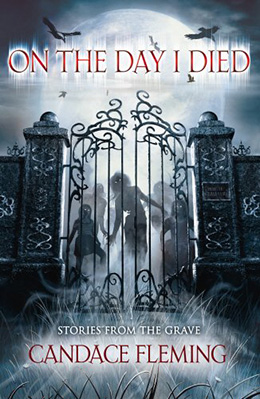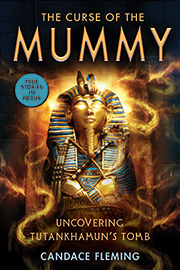BOOKS

Schwartz & Wade, July 2012
978–0‑375–86781‑1
ages 11 and up
Please find this book at your favorite public library or used bookseller.
After you’ve read On the Day I Died, try this book:
On the Day I Died
Stories from the Grave
Ten ghost stories for teen and older tween readers that are sure to send chills up their spines. Set in White Cemetery, an actual graveyard outside Chicago, each story takes place during a different time period from the 1860’s to the present, and each one ends with the narrator’s death. Some teens die heroically, others ironically, but all due to supernatural causes. Readers will meet walking corpses and witness demonic possession, all against the backdrop of Chicago’s rich history — the Great Depression, the World’s Fair, Al Capone and his fellow gangsters.
Reviews
“Nine creepy tales told by dead teens and positively tailor-made for reading — or reading aloud — by flashlight.
“Fleming uses a version of ‘The Vanishing Hitchhiker’ as a frame story and draws inspiration from several classic horror shorts, monster movies and actual locales and incidents. Within this frame,she sends a teenager into a remote cemetery where ghostly young people regale him with the ghastly circumstances of their demises. These range from being sucked into a magical mirror to being partially eaten by a mutant rubber ducky, from being brained by a falling stone gargoyle at an abandoned asylum to drowning in a car driven by a demonic hood ornament. Tasty elements include a malign monkey’s paw purchased at a flea market, a spider crawling out of a corpse’s mouth and a crazed florist who collects the heads of famous gangsters. Amid these, the author tucks in period details, offers one story written in the style of Edgar Allan Poe (‘As I pondered the wallpaper, its patterns seemed to crawl deep inside me, revealing dark secrets … No!’) and caps the collection with perceptive comments on her themes and sources. Light on explicit grue but well endowed with macabre detail and leavening dashes of humor.” (Kirkus Reviews, starred review)
“Dead men may tell no tales, but dead teenagers do. In this clever collection of ghost stories, 16-year-old Mike Kowalski discovers an abandoned cemetery for teenagers where nine 15- to 17-year-old ghosts tell him how they died. The stories span 100-odd years and give a colorful survey of Chicago through the decades and across classes (‘Back in those days, Chicago was lousy with funeral homes, what with all them gangsters running around’). Fleming has been rightly praised for her children’s nonfiction (Amelia Lost; The Great and Only Barnum), and underneath this group of chill-inducing tales lays a wealth of detail about Chicago’s historical immigrant communities, criminal underbelly, the 1893 World’s Fair, and more. (Sneaky!) They also span horror subgenres that include campy ’50s science fiction, gothic (‘Lily,’ starring a lovelorn high school student in 1999, is a faithful homage to ‘The Monkey’s Paw’), and wry Hitchcockian suspense; Fleming brings plenty of humor, too. The genre-flipping and varied narrative voices prevent any sense of monotony. A welcoming and well-written introduction to many styles of horror.” (Publishers Weekly, starred review)
“A boy driving recklessly down a country road at night narrowly avoids hitting the girl who steps out in front of his car. He takes her home — and ends up at her grave, beginning a night of spooky yarn-spinning as teenage ghosts gather to recount their death stories. The narrators include Edgar (1853–1870), whose madness led to murder; David (1943–1958), whose demise came at the hand of a “comic-book novelty”; and Lily (1982–1999), who died of a broken heart — and a broken neck. Fleming roots her stories firmly in time and place. Each teen speaks in the jargon of his or her day, and all the stories take place in the Chicago area. References to Al Capone, the World’s Columbian Exposition of 1893, and various sites and local lore give the tales a real-world specificity that adds to their horror. Because the stories’ outcomes aren’t in doubt, the suspense comes from seeing how it all unfolds. Fleming handles her tales with a light hand, going less for complex character development and more for thrills, chills, and, as in a story about a hoarder, the occasional ‘eww!’ ” (The Horn Book)
“Late one dark night, teenage Mike Kowalski drives to a deserted cemetery to return a pair of old-fashioned saddle shoes to a grave (don’t ask). Once there he is horrified to find himself surrounded by the ghosts of the many teenagers buried there, all of them, er, dying to tell him their stories. In one a wise guy uncovers an ancient curse; in another a boy enters a long-abandoned asylum for the insane; in yet another a girl encounters a hoarder’s House of Usher. Set in Chicago, each of these nine eerie ghost stories, Fleming explains, contains a kernel of truth about its setting — a city that, she notes, is ‘the spookiest place I know.’ Thus, in one story Al Capone makes a cameo appearance, and both the cemetery featured in the frame story and the terrifying old insane asylum really do exist. It is the combination of reality and imagination that lends a certain grave-itas (!) to these nine spectral stories. HIGH-DEMAND BACKSTORY: Fleming’s books for young readers, be they nonfiction, novels, or picture books, are always met with much anticipation.” (Booklist)


